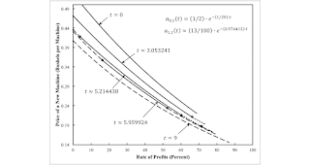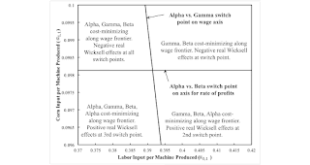This is another example of Engels explaining the theory of historical materialism. I know of this letter from Mills and Goldstick (1989). They also point out this letter from Engels. Here we see the metaphor of ideas "standing on their head", not in relation to Hegel's idealism, but as real economic relations reflected in finance. I like the emphasis on the interdependence of industries that could be expressed in Leontief matrices. Does this letter express a deterministic, strict dependence...
Read More »Prices In An Example Of The Life Of A Machine
Figure 1: Structural Economic Dynamics of the Price of a New Machine I am not sure that there is any great insight here. But this post depicts the evolution of prices in an example which I have been explaining in two posts. For some parameters, I have found that a shorter economic life of a machine may be associated with a more capital-intensive technique around a switch point. This can occur at both a 'normal' and a 'perverse' switch point. This finding raises difficulties for tradional...
Read More »Elsewhere
[embedded content]Does Learning How To Think In Coding Transfer More Generally?Another YouTube Video in the above series. I suspect some of us are not fans of some of those interviewed, although you must admit they changed the world. John Michael Colón, Wobbly Economics - Part I. A tribute to Fred Lee and an explanation of why you are right to distrust economists. Shattering 'Market Theory', an old post on Daily Kos, reporting a discussion on a private email list of one of my numeric...
Read More »A Letter From Marx To Engels In 1868 On The First Volume Of Capital
Over years, I have considered how Marx continues and differs from classical political economy. I have also documented some foreshadowings and outlines of the transformation problem. This is another letter in a series In this letter, Marx alludes to prices of production and the transformation problem. Apparently, he thinks at this time that volumes 2 and 3 will be a single volume. Here he sets out three points which he thinks are original to the first volume of Capital. The first is that...
Read More »Technological Progress In Industry And The Life Of A Machine In Agriculture
Figure 1: Variation of Switch Points with Technological Progress in Industry This post is an expansion on this post. Technological progress in industry, in which the machine is produced, can be illustrated in Figure 1 in the previous post by a movement roughly from off the graph to the upper right to below the lower left. More concretely, suppose each of the two non-zero coefficients of production in the machine industry decrease at a constant rate of σ0 and σ1 respectively. The two...
Read More »How Would Socialism Work?
[embedded content]On Another Topic, with an Appearance by Rutger Bregman. This post does not answer the question, but merely provides a bibliography. I have not read everything below. I suppose this is something of a hodge podge. I include a book from Peter Kropotkin, even though it is much older than the remaining non-fiction works, since I am currently one third, maybe, through it. Novels (Ken Macleod, in The Cassini Division has a more complete list as chapter titles.) Edward Bellamy....
Read More »A Letter From Marx To Engels In 1867 On The First Volume Of Capital
This is another letter in a series I have been transcribing in which Marx discusses Capital. In this letter, he says one of the two best points in his book is his discussion of labor expressed in use value or in exchange value. Since I have not read (an english edition of) the first edition, I cannot be sure of my ground here. Apparently, Marx revised Chapter 1 quite extensively among editions. Anyways, I think this expression of labor gets at the distinction between concrete and abstract...
Read More »The Emergence Of Non-Monotonic Variations In The Economic Life Of A Machine
Figure 1: A Part of the Parameter Space1.0 Introduction This post presents a perturbation of an example from Salvatore Baldone. It follows the style of some posts that almost add up to a draft research paper. A widespread view among Austrian-school and mainstream economists is mistaken. Given competitive markets, if the supply of capital were increased, in some sense, the rate of profits would supposedly be driven down. At the level of abstraction here, no distinction exists between the...
Read More »Leontief On Reswitching
An old puzzle is why do those who build on Leontief's empirical work not make more of Sraffa? And why do those who build on Sraffa's theory not interact more with those building on Leontief? Sraffa implicitly refers to Leontief, von Neumann, and others in the preface to his 1960 book. Those, like Zambelli, that have done empirical work on capital-theoretical 'paradoxes' draw on Leontief matrices constructed from national income and product accounts. So do those who are exploring empirical...
Read More »Is Socialism Possible?
The strongest argument against socialism, understood as entailing central planning, comes from Enrico Barone. Von Mises popularized this argument. Maybe he was subjectively original. I think von Mises did not have a good understanding of duality theory and shadow prices. Anyways, his argument is supposed to be an argument in principle, an impossibility argument. Oskar Lange, Abba Lerner, and Fred Taylor, for example, provided answers. Hayek proposed a revision emphasizing practicality and...
Read More » Heterodox
Heterodox



